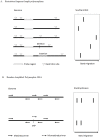Computational and experimental approaches to reveal the effects of single nucleotide polymorphisms with respect to disease diagnostics
- PMID: 24886813
- PMCID: PMC4100115
- DOI: 10.3390/ijms15069670
Computational and experimental approaches to reveal the effects of single nucleotide polymorphisms with respect to disease diagnostics
Abstract
DNA mutations are the cause of many human diseases and they are the reason for natural differences among individuals by affecting the structure, function, interactions, and other properties of DNA and expressed proteins. The ability to predict whether a given mutation is disease-causing or harmless is of great importance for the early detection of patients with a high risk of developing a particular disease and would pave the way for personalized medicine and diagnostics. Here we review existing methods and techniques to study and predict the effects of DNA mutations from three different perspectives: in silico, in vitro and in vivo. It is emphasized that the problem is complicated and successful detection of a pathogenic mutation frequently requires a combination of several methods and a knowledge of the biological phenomena associated with the corresponding macromolecules.
Figures




References
Publication types
MeSH terms
Substances
Grants and funding
LinkOut - more resources
Full Text Sources
Other Literature Sources

